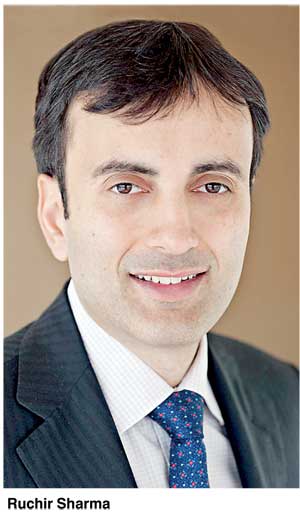Sunday Apr 06, 2025
Sunday Apr 06, 2025
Tuesday, 13 October 2015 00:03 - - {{hitsCtrl.values.hits}}
In 2013, the then Governor of the Central Bank Ajith Nivard Cabraal invited Ruchir Sharma, Head of Emerging Market Equities and Global Macro at Morgan Stanley Investments to deliver the Central Bank’s 63rd anniversary lecture. The title of his lecture was ‘The Prospects of Sri Lanka as a Breakout Nation’. The lecture was attended by senior staff of the bank, academics and the invited elite of commerce and industry.
A few months earlier he had authored ‘Breakout Nations – In Search of the Next Economic Miracles’. Its cover depicting a bluish globe in a pale gold hued oyster shell said it all. It was a best seller in the US, Europe and Asia. Sanjoy Roy, the producer of the Jaipur Literary Festival who accompanied Ruchir Sharma on a Penguin Books promotion in the United States, claimed: “Every hall was packed to the brim with well-known names from business, commerce, politics, industry and academia.”
Governor Cabraal, the chimeric Kautilya of the Mahinda Rajapaksa administration, had good and natural reasons for his exuberance for the affirmations of the Savant from Morgan Stanley investments. Here was a prophet who shared his per capita GDP obsession and the distributional effects of economic growth.
for the affirmations of the Savant from Morgan Stanley investments. Here was a prophet who shared his per capita GDP obsession and the distributional effects of economic growth.
Fortuitous forecast for Sri Lanka
Ruchir Sharma had identified Sri Lanka as a possible breakout nation. His reasoning was music to the ears of the Governor and President Rajapaksa whose constant mantra was the rate of growth and the per capita GDP. Ruchir Sharma was saying that Sri Lanka, even during the worst years of the civil war had managed an average annual growth rate hovering around 5%. Sri Lanka while rebuilding its economy in peace time over the next decade and creating a new trade regime with neighboring countries was well poised to achieve 7-8% growth.
Ruchir Sharma had reasons for his fortuitous forecast. President Mahinda Rajapaksa had told him: “China is my friend. India is my relation.” Ruchir Sharma concludes: “At peace, Sri Lanka finds itself in very strong position, courted by both of Asia’s emerging giants.” Then his nimble strategic mind warns: “There is some risk that the peace dividend could prove fleeting – 40% of nations that end a civil war will revert to violence within a decade.”
The purpose of this writer is to draw attention to a pivotal observation made by Sharma in his book published in 2012. His observation is spine-chilling in its eerie explosion of retrospective ‘Weltschmerz’. The Germans have a word for everything. It means ‘world pain.’
To make any sense of what Sharma has presciently painted he needs to be quoted at some length. I beg the readers to choose to endure.
“It is conventional military wisdom that guerrilla armies can be contained or driven off but not destroyed; however, by mid-2009 the Sri Lankan Army had proved that wisdom wrong. In an all-out offensive the Army cordoned off the Tigers in their stronghold on the northern Jaffna Peninsula, and in a feat rarely repeated in the age of mobile-phone cameras, it managed to seal the entire region from outside view. Then it pulled the cordon tight until Prabhakaran, his family, and most of the senior Tiger leaders were dead, along with untold thousands of civilians. The final stages of the war were highly controversial—charges of human-rights violations still fly against both sides —but the economic impact seems clear.”
In September 2014 Ruchir Sharma addressed an investor forum in New York attended by Nivard Cabraal and Minster Sarath Amunugama. He remains bullish on Sri Lanka. “…Another thing I find positive about Sri Lanka is that it is in the geographical sweet spot and this way I think Sri Lanka has done a great job of playing China and India” [Media release CSE 17 November 2014].
The OHCHR report
Ruchir Sharma is an expert on emerging markets and economic meltdowns. He is no expert on emerging political meltdowns. His strategic mind however compelled him to caution against a cataclysm that lurked in someplace. Let us fast-forward to the OHCHR report.
“On 18 May 2009, the Defence Ministry announced that LTTE leader Prabhakaran and several other senior LTTE leaders had been killed in the fighting and the Sri Lankan Government formally announced its military victory over the LTTE and complete territorial control over the entire country.”
“OISL is in possession of high resolution electronic photos of a group of dead bodies, among them clearly identifiable are Puleedevan, Nadesan, and Vineetha Nadesan, as well as a number of recognisable but unidentified men and possibly a young woman (face outside the frame of the photo). According to a forensic pathologist, the colour digital photographs are all amateur ‘trophy-type’ images which show groups of bodies, individual bodies and include images of head and shoulders. Despite their amateur nature, these photographs capture many injuries, patterns of blood flow, disturbance of clothing and post-mortem changes.”
“OISL is in possession of photographic and video material that show Balachandran Prabhakaran, the 12-year-old son of Vellupillai  Prabhakaran, sitting in a bunker, alive and in the custody of Sri Lankan troops as well as images of the dead body of Balachandran lying on the ground beside the dead bodies of five semi-naked men. Based on the assessment of an independent forensic pathologist of the photographs, Balachandran appears to have been killed with five gunshots to the chest. One gunshot wound with soot markings indicate the weapon was fired from a distance of 60-90 cm. A witness stated he saw Balachandran alive and then saw his body with bullet wounds; he did not see Balachandran being killed.”
Prabhakaran, sitting in a bunker, alive and in the custody of Sri Lankan troops as well as images of the dead body of Balachandran lying on the ground beside the dead bodies of five semi-naked men. Based on the assessment of an independent forensic pathologist of the photographs, Balachandran appears to have been killed with five gunshots to the chest. One gunshot wound with soot markings indicate the weapon was fired from a distance of 60-90 cm. A witness stated he saw Balachandran alive and then saw his body with bullet wounds; he did not see Balachandran being killed.”
“The well-known LTTE news presenter, Isaipriya, appears in several photographic and video images that suggests she was taken into custody and killed by the Sri Lankan security forces.”
The OHCHR report is published. The final resolution co-sponsored by Sri Lanka has been adopted by acclamation. Crusade, Jijad and Dharmavijaya are synonyms for the same asininity. Ruchir Sharma has been wrong. Our Army has not managed to “seal the entire region from outside view”.
A just peace
In another place in another time Hannah Arendt wrote: “Despite all the efforts of the prosecution, everybody, could see that this man was not a ‘monster,’ but it was difficult indeed not to suspect that he was a clown.”
Soldiers are tools of war. You make them heroes at your peril. As in any other human institution in soldiery, there are the lazy, the diligent, the honest and the deceitful, humane and cruel, kind and the pitiless. They cannot all be heroes. The raison d’être of a just war is the just peace that follows it.
Discover Kapruka, the leading online shopping platform in Sri Lanka, where you can conveniently send Gifts and Flowers to your loved ones for any event including Valentine ’s Day. Explore a wide range of popular Shopping Categories on Kapruka, including Toys, Groceries, Electronics, Birthday Cakes, Fruits, Chocolates, Flower Bouquets, Clothing, Watches, Lingerie, Gift Sets and Jewellery. Also if you’re interested in selling with Kapruka, Partner Central by Kapruka is the best solution to start with. Moreover, through Kapruka Global Shop, you can also enjoy the convenience of purchasing products from renowned platforms like Amazon and eBay and have them delivered to Sri Lanka.
Discover Kapruka, the leading online shopping platform in Sri Lanka, where you can conveniently send Gifts and Flowers to your loved ones for any event including Valentine ’s Day. Explore a wide range of popular Shopping Categories on Kapruka, including Toys, Groceries, Electronics, Birthday Cakes, Fruits, Chocolates, Flower Bouquets, Clothing, Watches, Lingerie, Gift Sets and Jewellery. Also if you’re interested in selling with Kapruka, Partner Central by Kapruka is the best solution to start with. Moreover, through Kapruka Global Shop, you can also enjoy the convenience of purchasing products from renowned platforms like Amazon and eBay and have them delivered to Sri Lanka.